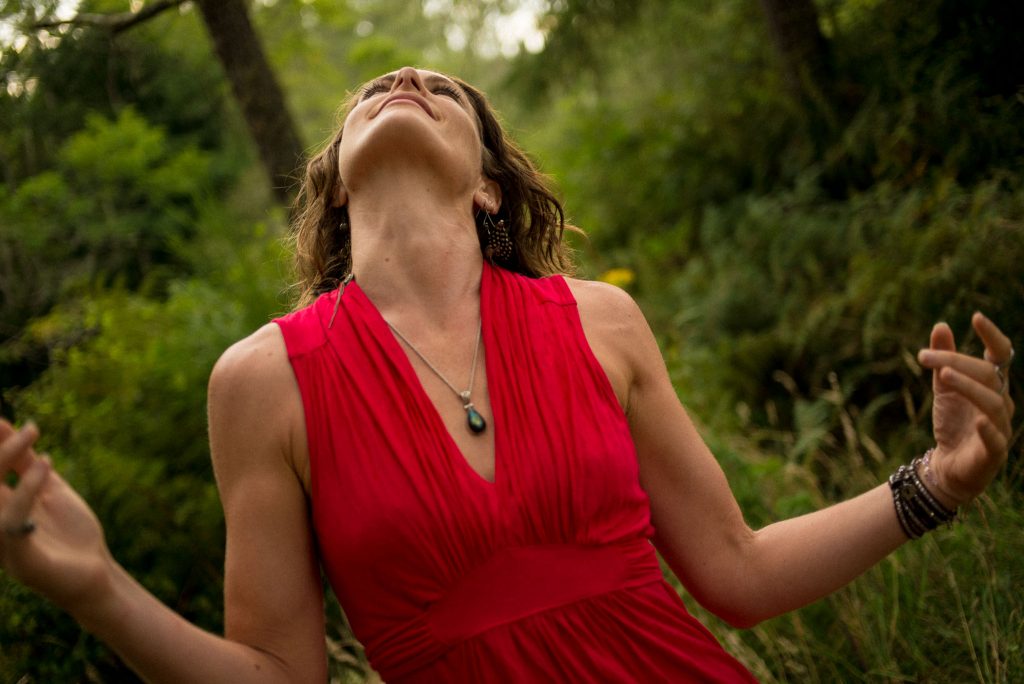 How do we open to the energy of Maha Shakti, the Great Divine Mother? Photo Credit: Pete Longworth
How do we open to the energy of Maha Shakti, the Great Divine Mother? Photo Credit: Pete Longworthby Kara-Leah Grant
I’m leading a Women’s Circle at Power Living Wellington on July 8th where I’ve promised that women will learn how to embody and evoke the energy of Maha Shakti – one aspect of the Divine Feminine – through the practice of asana, pranayama and meditation.
But what does that mean?
I feel the energy of Shakti in me when I practice, when I walk, when I dance, when I write, when I make love. She is always there, within, only a breath away from my awareness.
But how do I describe her using words?How do I conceptualise and intellectualise her?
I turn to my library of Tantric books – the big names including Georg Feurnstein and David Frawley. Yet the words seem dry and shrivelled – descriptions of a phenomena that the authors may or may not have experienced. Like someone describing Mount Everest when they have never seen it, let alone stood on its slopes.
There is another way in though – a way that makes more sense to our conceptual minds, which likes to grasp on to ideas. It’s through the material, rather than the subtle realms.
In our material world, examining our relationship to our own mothers can help us access Maha Shakti, an aspect of the Divine Feminine, by removing any obstacles or blocks to the free flow of this energy.
And not just our relationships to our mothers, but also our relationship to mothering as an energy within our lives, whether we have children or not.
What does it mean to mother? What does it mean to be mothered?
Each one of us will have a different answer to those questions, depending on our personal experiences. It doesn’t matter what those answers are, only that we have taken the time to inquire into our experiences.
This is the path of self-knowledge, leading to self-realisation. If we have never asked ourselves these questions and if we have never examined the nature of our relationship to mother and mothering then we often remain unconscious of these forces within us.
The fastest way to bring these energies into consciousness is usually by examining our relationship to the person who is our mother – whether biological, adoptive or other. Mothers can arrive in our lives through many different avenues.
This examination can be painful because we don’t always want to see what is there. Do we want to acknowledge that our mother was too self-absorbed to care about her children?
Or that she was completely worn down by the demands placed upon her?
Or that her love was tainted by a deep desire for approval from us that always elicited feelings of unconscious discomfort?
Often we’d rather keep the idealised vision we have of our mother as being the one who loved us unconditionally and was always there for us.
Facing her shadow means that we may have to start looking at our own shadow.
Which is really what all this work is about – peering into the shadows to bring forth that which has been unconsciously driving us and shaping our apparent destinies.
Because if we’re afraid to look, then life will dish us up in flashing neon lights the very thing we’re afraid to look at.
My parents divorced when I was 12 and as a teenager, I witnessed my mother’s experience of single motherhood, attempting to bring up three teenagers while working full time, with no family assistance.
I never paid close attention to our relationship, preferring not to look too close. And I didn’t examine my relationship to mothering. I avoided it all. I did know that I didn’t want to end up the way my mother did – a single parent on her own and struggling.
And as a result, I began a journey inward to understand my relationship to my mother more deeply, and our maternal line. That then informed my journey to better understand how I was showing up as mother to my son.
Through it all, I saw my shadows, my weaknesses, my unconscious patterns, and my disempowered Feminine in action. I saw the misery I was creating and the damage I could do.
And, as my mother had vowed a generation before me, I also vowed that I would break the patterns of my maternal line. My vow built on my mother’s vow. Women, standing together, to look at how they were mothered, and to determine what they would no longer carry on for their children.
My mother’s vow broke a pattern of physical abuse and an atmosphere of terror. My vows are making emotional literacy and self-knowledge keystones of parenting.
And along the way, I’m learning how to mother myself – how to internalise the Great Divine Mother as if she is me, which She is.
This is what brings the energy of the Goddess, of Maha Shakti, alive in us. It’s not just making conscious and understanding our relationship to mothering; it’s also doing the work necessary to internalise and become our own Divine Great Mothers.
Because until we can mother ourselves as the Goddesses we are, we can’t bring the power of Shaki into our worldly actions.
And this is why we don’t have to know any Yoga philosophy to work with the energy of Maha Shakti. We don’t have to understand what this energy is on an intellectual, conceptual level. It’s irrelevant.
All that we need is a willingness to look within ourselves and examine our relationship with mother and mothering. Everything we need will spring from that self-inquiry and examination.
When this is combined with the power of meditation, pranayama and asana – as it will be at Power Living Wellington on July 8th – we move beyond our knowing and into an embodied experience of Maha Shakti.
This dance between self-inquiry and embodiment flows back and forth from one to the other as the embodiment practices give rise to insights, and insights give rise to increased embodiment.
When one is stuck, we can turn to the other to find freedom.
This is the movement, the dance, between consciousness and energy, between Shiva and Shakti.
This is the Union that we know as Yoga.
And it is this that gives rise, in time, to our own Realization, to the birth of a new Consciousness.


[…] By meeting motherhood consciously as path we engage with a mighty force for self-transformation that has the power to affect us all; our children, our families, our communities and our world, across generations. […]